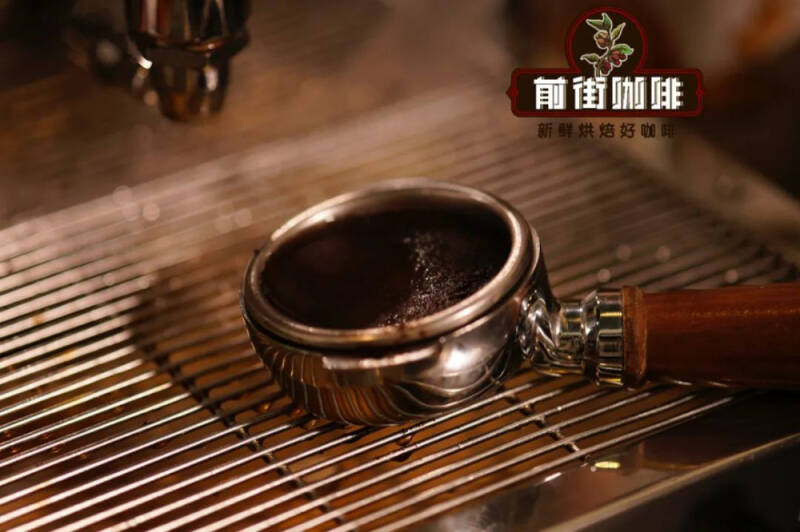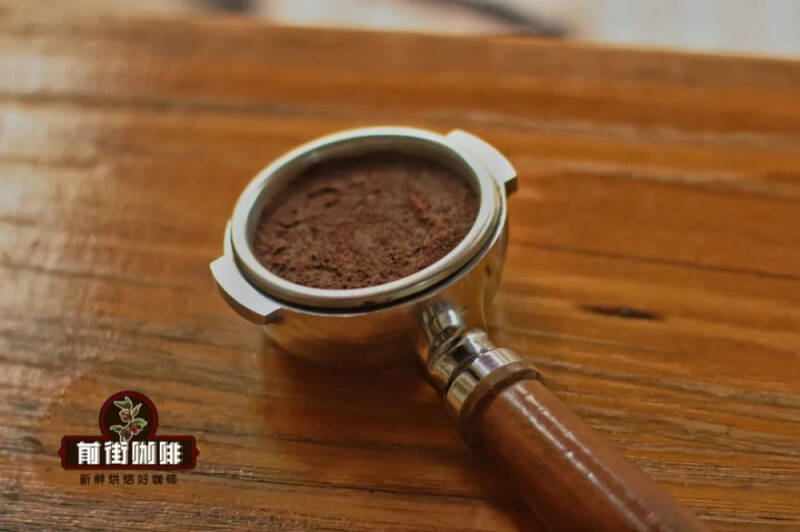Does the stagnant water after the powder bowl extraction of espresso has anything to do with the powder bowl and water distribution network? How to adjust the extraction parameters?
Friends with toy machines, has this also happened: after cooking, take off the handle and find that the whole pressed powder is wet, there is still a lot of stagnant water on the surface, and the pressed powder knocked out is not shaped like a mud lump.

Under normal circumstances, after the extraction of concentrated coffee pressed powder should be a relatively dry state, knocked out of the pressed powder should also be a relatively complete, solid cake fast. If the above wet, soft state, knitting water problems, it is not a normal phenomenon. Today, Qianjie Coffee will talk to you about what factors will cause the stagnant water problem.

The coffee powder is too fine.
Italian machine extraction is the use of hot water under high temperature and high pressure, when grinding is too fine, the gap between coffee particles and particles in the powder bowl will be greatly reduced, even if the coffee machine reaches the maximum pressure value, hot water is also difficult to extract flavor substances through these gaps. At the end of the extraction, there may be part of the water failed to pass through the powder layer in time, accumulated in pressed powder, there will be wet mud lump, or even stagnant water.
Usually the most obvious phenomenon of fine grinding extraction is that the pressure gauge has reached the peak pressure for more than ten seconds, but the coffee liquid is still in a slow dripping extraction state, and the extraction time is relatively longer.
Because the grinding is too fine to lead to stagnant water problem, it is good to find and solve very well, properly adding the grinding degree of coarse coffee powder can adjust this phenomenon.
Coffee beans are not fresh
When the beans are not fresh, it is difficult to judge the cause of the stagnant water in the powder bowl. This situation usually occurs in individual Italian players with a small amount of cups. Under the consumption of one or two servings a day, a packet of spaghetti beans may be used for a month, and the carbon dioxide in the beans is almost dissipated.
You know, like hand brewing, the Italian coffee machine will also steam the coffee powder during extraction, that is, pre-soaking. When the coffee powder contains carbon dioxide, it expands under the action of hot water and fills the gap between the particles; if there is little carbon dioxide left in the bean question, it will not expand, and the flow rate of the coffee liquid will be faster at the same grinding degree.
Usually the concentrated oil extracted in this way is not rich or even absent, it is very watery, and the problem of stagnant water in powder bowls occurs frequently. When there are conditions, it is recommended to choose fresh coffee beans.
Too much or too little powder
Usually the powder bowl we use has a standard that can hold the amount of powder, and different types of powder bowls can hold different amounts of powder.
If you simply want to concentrate a little higher and increase the amount of powder, resulting in exceeding this limit, it will cause a series of problems such as "the concentrated extraction cannot be extracted, and after the handle is removed, the surface of the powder bowl is wet, but the coffee powder at the bottom of the bowl is dry." there is a pile of coffee powder sticking to the water distribution network.
However, if the amount of coffee powder used is too much less than the standard gram weight of the powder bowl, it will lead to serious stagnant water in the powder bowl after extraction and, more extreme, a puddle of coffee water will be spilled when the handle is removed.
(when the amount of powder is lower than that of the groove)
We need to know that the coffee machine releases a column of water with pressure during extraction, and when the extraction key is turned off to stop extraction, the pressure relief valve opens, and a reverse pressure is formed in the sealed handle powder bowl to discharge the excess water from the pressed powder through the relief valve. But when you have too little coffee powder and the distance between pressed powder and vermicelli is too large, it is easy to form stagnant water in the bowl.
If you can't judge whether the amount of powder you use matches the powder bowl, you can take a look at a concave line of the powder bowl. After pressing the powder bowl, you can see if it can just reach the depression. If you are too high to explain that there is too much powder, and if you are too low, you will have less powder.
Qianjie coffee daily debugging extraction parameters, for example, Qianjie uses a 20g powder bowl, in debugging will not use more than 20g powder, if you need to use more than 20g powder, Qianjie will choose to slightly refine the grinding degree; when the flavor is close, sometimes choose to reduce the amount of powder by a few grams, but the amount of powder will not be less than 19.7g.
Purge head to relieve pressure
The brewing head has not been cleaned for a long time, or the cleaning is not thorough, and the long-term backlog of coffee grounds leads to the damage of pipe drainage or drainage function, resulting in too much water in the powder bowl after each extraction.
If it is not serious, we only need to keep the head clean and wash it regularly with a special coffee machine cleaner; but if it still cannot be solved, it is recommended to contact customer service for inspection and maintenance.
The pressure of the Italian coffee machine is insufficient or unstable
Insufficient pressure is a common situation in household coffee machines, when the pressure is not enough or unstable, the pressure gauge appears "repeated horizontal jump".
(for reference only)
The most intuitive performance is that the extraction column suddenly changes from thick to thin, which will cause the pressure check valve not to have enough pressure backsuction, and finally a large amount of stagnant water remains after the handle is removed.
-END-
Front Street Cafe
No. 10 Baoqian street, Yandun road, Dongshankou, Yuexiu district, Guangzhou, Guangdong province
Important Notice :
前街咖啡 FrontStreet Coffee has moved to new addredd:
FrontStreet Coffee Address: 315,Donghua East Road,GuangZhou
Tel:020 38364473
- Prev

Why is the extraction pressure of espresso 9bar? What does it have to do with the extraction parameters and how to adjust it?
Qianjie Coffee often says that as long as we understand the relationship between espresso extraction parameters, a good espresso is readily available (exaggerated), and these extraction parameters are grinding degree, powder content, powder-to-liquid ratio, and extraction time. But you know what, there is another parameter that is actually quite important.
- Next

Netizen: is the threshold of the coffee shop so low?!
▲ Click to follow | Daily boutique Coffee Culture Magazine Coffee Workshop Coffee is becoming more and more popular among young people. Customers who come in for coffee have changed from a simple and casual "have a cup of American style" to seriously asking "what kind of beans is this?" In addition to the demand for caffeine, consumers are also gradually mastering some coffee
Related
- Customers have "changed" Manner's new products! Shop assistant: Please don't mess around!
- Remove sockets in customer areas at Starbucks stores?! Netizen: I won't go if I really tear it down
- What is the difference between the taste steps of sun-dried coffee and washed coffee? Why is sun-cured coffee sweeter and washed coffee sour?
- The recipe for salty grapefruit dirty is revealed! Coffee Festival salty grapefruit dirty coffee making materials parameters ratio milk share!
- How about the flavor of Sunlight 74158 at Sidamo Banshaha Mathieu Processing Factory in Ethiopia? 74158 Share the proportion of coffee brewing parameters!
- What effect does Italian American coffee with filter paper have? Will coffee taste better if it is put on filter paper at the bottom of the powder bowl?
- What is the color difference in coffee beans? What are the characteristics of honey processed coffee beans? Why are the anaerobically treated coffee beans uneven in color?
- How does novice Xiaobai quickly get started and make coffee? Newbies learn to make coffee by hand and share the specific steps and process process!
- Costa tea has a shelf life of 100 years?! Expert: Unable to verify
- It's a huge uproar! American milk addition was rejected by Manner employees?!

